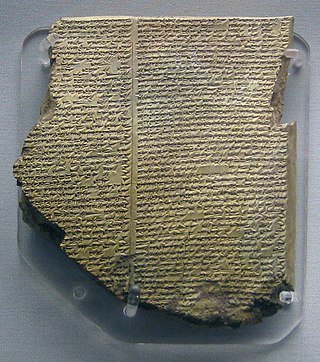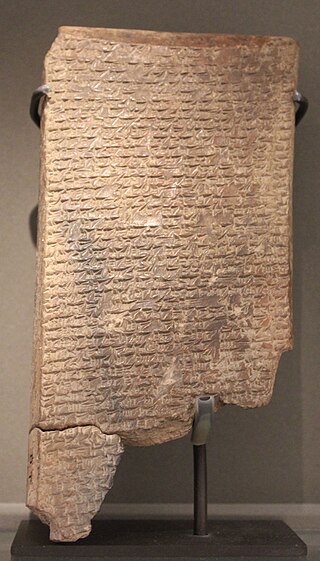Related Research Articles

The Book of Job, or simply Job, is a book found in the Ketuvim ("Writings") section of the Hebrew Bible (Tanakh), and is the first of the Poetic Books in the Old Testament of the Christian Bible. Scholars are generally agreed that it was written between the 7th and 4th centuries BCE. It addresses theodicy, why God permits evil in the world, through the experiences of the eponymous protagonist. Job is a wealthy and God-fearing man with a comfortable life and a large family; God, having asked Satan for his opinion of Job's piety, decides to take away Job's wealth, family and material comforts, following Satan's accusation that if Job were rendered penniless and without his family, he would turn away from God.
Akkadian literature is the ancient literature written in the Akkadian language in Mesopotamia during the period spanning the Middle Bronze Age to the Iron Age.

The Epic of Gilgamesh is an epic poem from ancient Mesopotamia. The literary history of Gilgamesh begins with five Sumerian poems about Bilgamesh, king of Uruk, dating from the Third Dynasty of Ur. These independent stories were later used as source material for a combined epic in Akkadian. The first surviving version of this combined epic, known as the "Old Babylonian" version, dates back to the 18th century BC and is titled after its incipit, Shūtur eli sharrī. Only a few tablets of it have survived. The later Standard Babylonian version compiled by Sîn-lēqi-unninni dates from the 13th to the 10th centuries BC and bears the incipit Sha naqba īmuru. Approximately two-thirds of this longer, twelve-tablet version have been recovered. Some of the best copies were discovered in the library ruins of the 7th-century BC Assyrian king Ashurbanipal.

Utu, also known under the Akkadian name Shamash, was the ancient Mesopotamian sun god. He was believed to see everything that happened in the world every day, and was therefore responsible for justice and protection of travelers. As a divine judge, he could be associated with the underworld. Additionally, he could serve as the god of divination, typically alongside the weather god Adad. While he was universally regarded as one of the primary gods, he was particularly venerated in Sippar and Larsa.

The land of Subartu or Subar is mentioned in Bronze Age literature. The name also appears as Subari in the Amarna letters, and, in the form Šbr, in Ugarit.

Wisdom literature is a genre of literature common in the ancient Near East. It consists of statements by sages and the wise that offer teachings about divinity and virtue. Although this genre uses techniques of traditional oral storytelling, it was disseminated in written form.

Nebuchadnezzar I or Nebuchadrezzar I, reigned c. 1121–1100 BC, was the fourth king of the Second Dynasty of Isin and Fourth Dynasty of Babylon. He ruled for 22 years according to the Babylonian King List C, and was the most prominent monarch of this dynasty. He is best known for his victory over Elam and the recovery of the cultic idol of Marduk.

The Gilgamesh flood myth is a flood myth in the Epic of Gilgamesh. Many scholars believe that the flood myth was added to Tablet XI in the "standard version" of the Gilgamesh Epic by an editor who used the flood story from the Epic of Atrahasis. A short reference to the flood myth is also present in the much older Sumerian Gilgamesh poems, from which the later Babylonian versions drew much of their inspiration and subject matter.

Apkallu (Akkadian) and Abgal are terms found in cuneiform inscriptions that in general mean either "wise" or "sage".
Kakka was a Mesopotamian god best known as the sukkal of Anu and Anshar. His cult center was Maškan-šarrum, most likely located in the north of modern Iraq on the banks of the Tigris.

Nazi-Maruttaš, typically inscribed Na-zi-Ma-ru-ut-ta-aš or mNa-zi-Múru-taš, Maruttašprotects him, was a Kassite king of Babylon c. 1307–1282 BC and self-proclaimed šar kiššati, or "King of the World", according to the votive inscription pictured. He was the 23rd of the dynasty, the son and successor of Kurigalzu II, and reigned for twenty six years.

Ludlul bēl nēmeqi, also sometimes known in English as The Poem of the Righteous Sufferer, is a Mesopotamian poem written in Akkadian that concerns itself with the problem of the unjust suffering of an afflicted man, named Šubši-mašrâ-Šakkan (Shubshi-meshre-Shakkan). The author is tormented, but he does not know why. He has been faithful in all of his duties to the gods. He speculates that perhaps what is good to man is evil to the gods and vice versa. He is ultimately delivered from his sufferings. It is thought to have been composed during the reign of Kassite king of Babylon Nazi-Maruttaš, who is mentioned on line 105 of tablet IV.
The Dialogue of Pessimism is an ancient Mesopotamian literary composition in the form of a dialogue between a master and his slave. Its interpretations have varied, but it is generally considered an unusual text which thematises the futility of human action. It is an example of ancient Near Eastern wisdom literature.
A lilu or lilû is a masculine Akkadian word for a spirit or demon.

Enlil-nādin-aḫe, “Enlil gives a brother,” or Enlil-šuma-uṣur, “Enlil protect the son,” depending on the reading of –MU-ŠEŠ, ca. 1157—1155 BC, was the 36th and final king of the Kassite or 3rd dynasty that had ruled over Babylon and the land known as Karduniash since perhaps around 1500 BC.
Adad-apla-iddina, typically inscribed in cuneiform mdIM-DUMU.UŠ-SUM-na, mdIM-A-SUM-na or dIM-ap-lam-i-din-[nam] meaning the storm god “Adad has given me an heir”, was the 8th king of the 2nd Dynasty of Isin and the 4th Dynasty of Babylon and ruled c. 1064–1043. He was a contemporary of the Assyrian King Aššur-bêl-kala and his reign was a golden age for scholarship.
Mesopotamian prayer are the prayers of ancient Mesopotamia. There are nine classifications of poem used within Mesopotamia.

The Dialogue between a Man and His God is the earliest known text to address the answer to the question of why a god permits evil, or theodicy, a reflection on human suffering. It is a piece of Wisdom Literature extant on a single clay cuneiform tablet written in Akkadian and attributed to Kalbanum, on the last line, an individual otherwise unknown. It is dated to the latter part of the Old Babylonian period, around about the reign of Ammi-Ditana according to Lambert, and is currently housed in the Louvre Museum, accession number AO 4462. It is of unknown provenance as it was purchased from an antiquities dealer by the Museum in 1906. It shares much of its style with an earlier Sumerian work, “Man and His God”, a penitential prayer of the UR III period.
Counsels of Wisdom is a piece of Babylonian wisdom literature written in Akkadian containing moral exhortations. It is composed primarily of two-line units, without sections. A translation of extant portions of the text was published in Lambert 1996. Existing manuscripts are fragmentary, but the original was estimated to be about 160 lines.
References
- 1 2 W. G. Lambert. "Babylonian Theodicy". Electronic Tools and Near East Archives. Retrieved 2015-06-10.
- ↑ Olof Pedersén (2011). "Excavated and Unexcavated Libraries in Babylonia". In Eva Christiane Cancik-Kirschbaum; Margarete van Ess; Joachim Marzah (eds.). Babylon: Wissenskultur in Orient und Okzident. Walter de Gruyter. p. 56. ISBN 9783110222111. (via identification of < Middle Babylonian Period > in The Babylonian World edited by Gwendolyn Leick (Jon Taylor - p.440)
- 1 2 3 4 John Gwyn Griffiths (1991). The Divine Verdict: A Study of Divine Judgement in the Ancient Religions. BRILL. ISBN 9004092315.
- 1 2 3 4 5 Carol A. Newsom (2003). The Book of Job : A Contest of Moral Imaginations. Oxford University Press. pp. 91–92. ISBN 9780195348712.
- 1 2 3 4 Wilfred G. Lambert (1996). Babylonian Wisdom Literature (reprint). Eisenbrauns. ISBN 9780931464942.
- ↑ Edward L. Greenstein (2014) "Job" in Adele Berlin and Marc Zvi Brettler (eds.) The Jewish Study Bible (second edition). New York: Oxford University Press.
- ↑ Barbara Chatton - Using Poetry Across the Curriculum: Learning to Love Language (p.43) ABC-CLIO, 2010, 241 pages, ISBN 1591586976[Retrieved 2015-06-10]